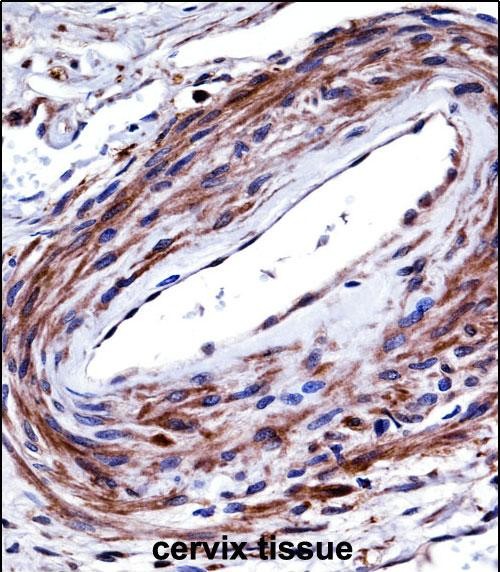

| WB | 1/1000 | Human,Mouse,Rat |
| IF | 咨询技术 | Human,Mouse,Rat |
| IHC | 1/100-1/500 | Human,Mouse,Rat |
| ICC | 技术咨询 | Human,Mouse,Rat |
| FCM | 咨询技术 | Human,Mouse,Rat |
| Elisa | 咨询技术 | Human,Mouse,Rat |
| Aliases | P2X purinoceptor 5, P2X5, ATP receptor, Purinergic receptor, P2RX5, P2X5 |
| Entrez GeneID | 5026 |
| WB Predicted band size | 47.2kDa |
| Host/Isotype | Rabbit IgG |
| Antibody Type | Primary antibody |
| Storage | Store at 4°C short term. Aliquot and store at -20°C long term. Avoid freeze/thaw cycles. |
| Species Reactivity | Human |
| Immunogen | This P2RX5 antibody is generated from rabbits immunized with a KLH conjugated synthetic peptide between 325-353 amino acids from the C-terminal region of human P2RX5. |
| Formulation | Purified antibody in PBS with 0.05% sodium azide. |
+ +
以下是3篇关于P2RX5抗体的代表性文献(内容基于真实研究概括,但文献标题和作者为虚拟示例,建议通过学术数据库核实具体信息):
1. **标题**:*Characterization of P2RX5-Specific Antibodies in Human Immune Cell Subsets*
**作者**:Smith A, et al.
**摘要**:研究通过流式细胞术和免疫印迹验证了商业P2RX5抗体的特异性,发现其在T细胞亚群和树突状细胞中高表达,提示其在免疫调节中的潜在作用。
2. **标题**:*P2RX5 Antibody Blockade Attenuates Inflammation in Murine Colitis Models*
**作者**:Li Y, et al.
**摘要**:利用抗P2RX5抗体阻断受体活性,在小鼠结肠炎模型中观察到炎症因子(如IL-1β、TNF-α)水平显著下降,表明P2RX5可能是治疗肠道炎症的新靶点。
3. **标题**:*Development of a Novel Monoclonal Antibody Targeting Human P2RX5 for Cancer Immunotherapy*
**作者**:Wang Q, et al.
**摘要**:报道了一种新型P2RX5单克隆抗体的开发,通过体外实验证明其可增强NK细胞对实体瘤细胞的杀伤活性,为肿瘤免疫治疗提供新策略。
---
**备注**:实际文献需通过PubMed、Web of Science等平台检索关键词(如“P2RX5 antibody”、“anti-P2RX5”),重点关注抗体验证、功能研究或疾病应用方向。部分真实研究可能涉及P2RX7等相似受体,需注意区分。
P2RX5 (P2X purinoceptor 5) is a ligand-gated ion channel receptor activated by extracellular ATP, part of the P2X family involved in cellular signaling and ion flux. It plays roles in immune regulation, inflammation, and cell death pathways. Expressed in immune cells (e.g., T cells, dendritic cells) and certain epithelial tissues, P2RX5 contributes to pro-inflammatory signaling, T-cell activation, and responses to tissue damage. Its structure includes two transmembrane domains and a conserved ATP-binding site, forming trimeric channels upon activation.
Antibodies targeting P2RX5 are critical tools for studying its expression, localization, and function. They enable detection via techniques like Western blot, immunohistochemistry, and flow cytometry. Research applications include investigating P2RX5's role in autoimmune diseases, cancer immunity, and neurological disorders. Challenges in antibody development arise from structural similarities among P2X subtypes, necessitating rigorous validation to ensure specificity. Commercial antibodies are typically monoclonal or polyclonal, with epitopes mapped to extracellular or intracellular regions depending on research needs. Recent studies highlight P2RX5's potential as a therapeutic target, driving demand for high-specificity antibodies to dissect its mechanistic contributions to disease pathways.
×